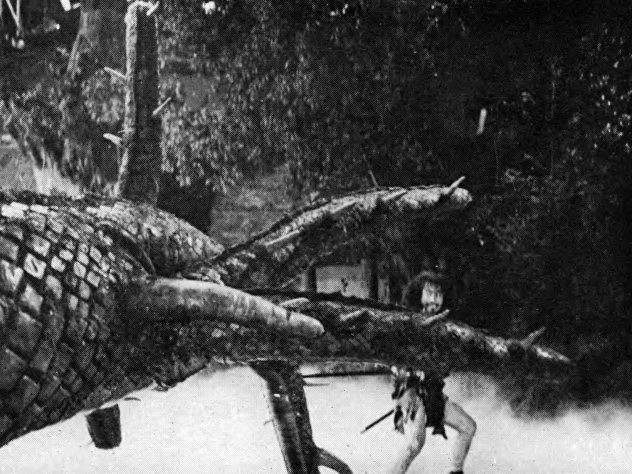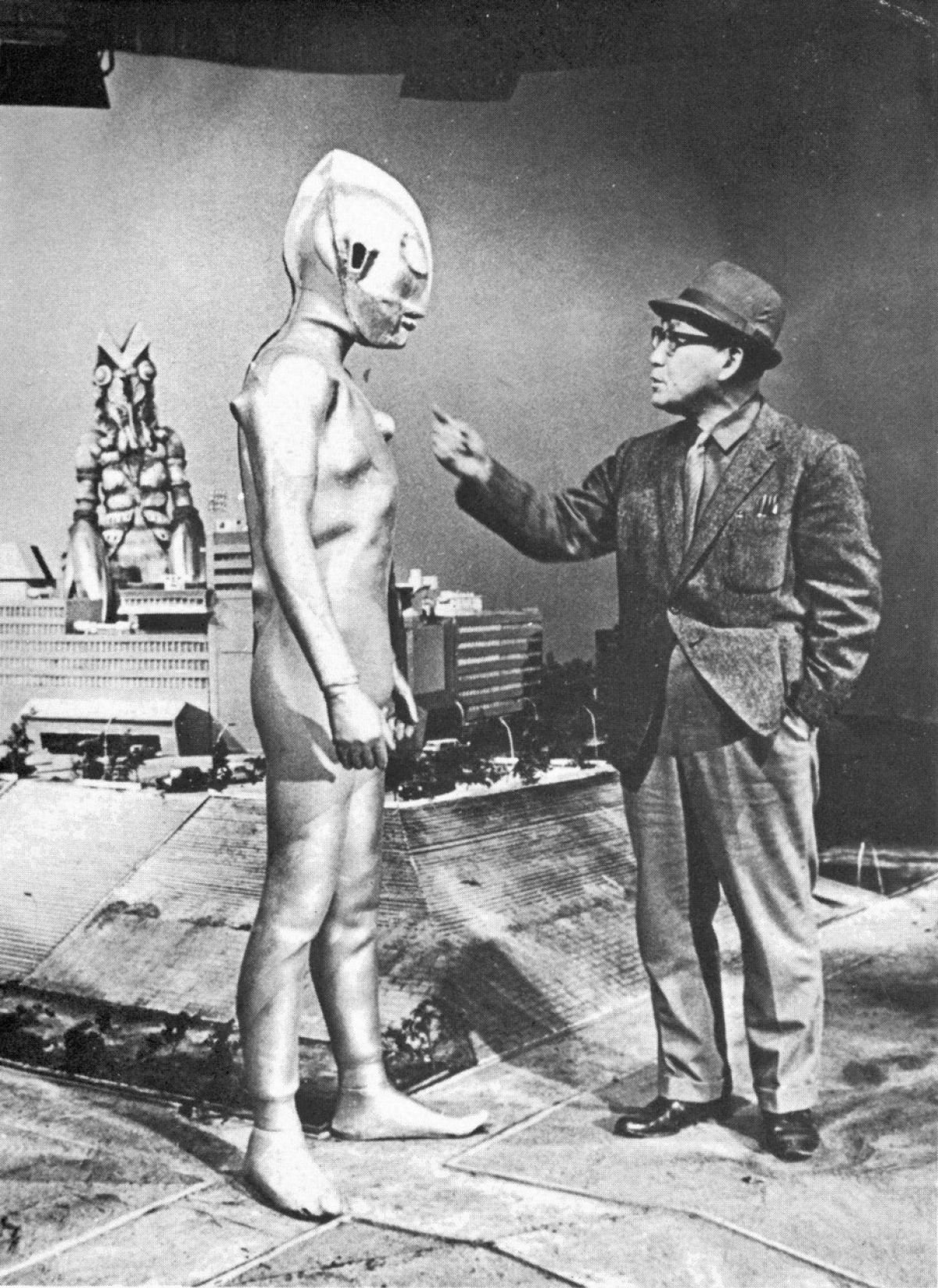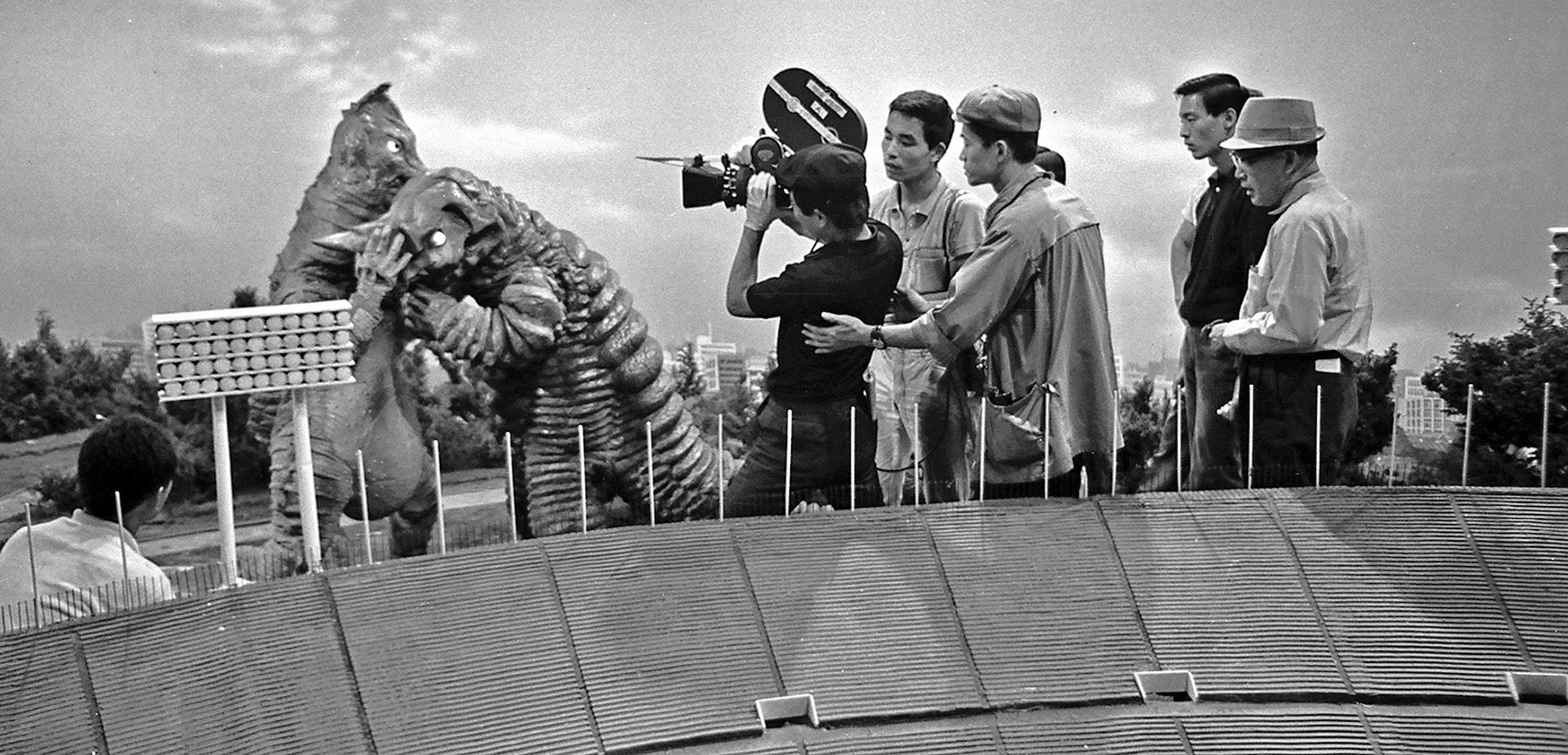
Japan’s Master of Monsters — Eiji Tsuburaya
Keen imagination and resourcefulness mark the unusual films conceived, produced and photographed by Eiji Tsuburaya, Japan’s leading exponent of science-fiction thrillers.
This article originally appeared in AC August 1960. Some photos are additional of alternate.
Eiji Tsuburaya, veteran cinematographer of Japan’s Toho Studios, holds one of the most unusual jobs in the movie world. He photographs monsters.
What sets him apart from other cameramen who work in this specialized field is that he’s a sort of jack-of-all trades who not only films the scary creatures, but dreams them up, writes stories around them and assumes many of the chores of producer and director to bring them to the screen.

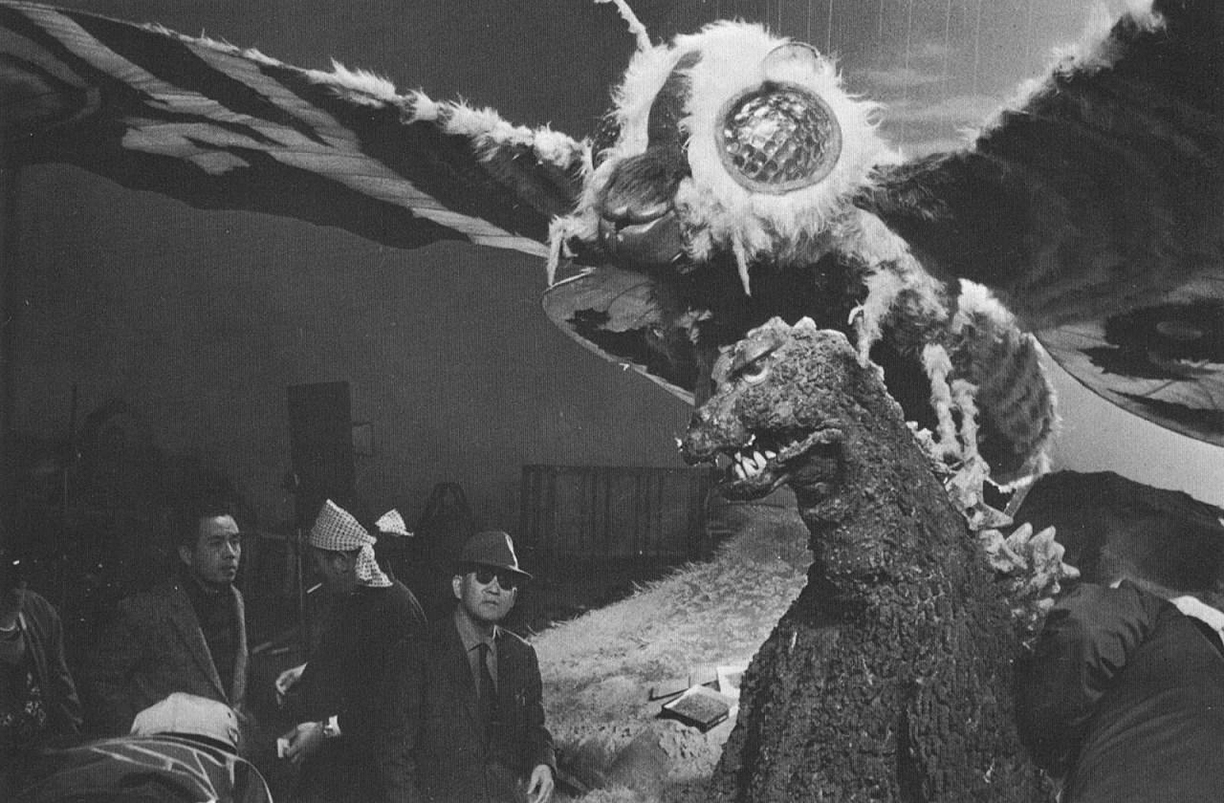
In recent years these monsters have comprised a lengthy parade. American audiences first saw Tsuburaya’s work in the thriller Godzilla, which starred a prehistoric reptile. Equally gruesome monsters crawled or walked through the films Radon, The H-Man and The Mysterians. Two of these Japanese-made movies played in several large American cities simultaneously.
The man behind these ambitious projects is a glutton for work. Recently he tackled no less a project than the mythical creation of Japan for the three-hour epic The Three Treasures. For this picture, said to be Toho’s 1,000th production and billed as “Japan’s The Ten Commandments,” he conjured up a giant, multi-headed sea serpent to torment the film’s star, Toshiro Mifune (Rashomon and Rickshaw Man).
While Tsuburaya was at work, he also whipped up the eruption of Mt. Fuji and a fearsome storm at sea for good measure.
Although this picture was a group effort in which many persons at the studio took part, it was Tsuburaya, the photographer of monsters, who contributed much of the film’s most dramatic moments.
While his specialty is weird creatures, he also masterminds all the miniature and special effects work required for other Toho pictures in production.
His private domain at the edge of the lot is a barn-like structure surrounded by a cluster of workshops. From this stage he commands a small army of miniature makers, special effects men and photographers.
A typical Tsuburaya picture begins when he comes up with some new and horrible being. Immediately he hammers out a rough plot and hands it over to scenario writers for completion. At the same time he sets his workers to the task of making the miniatures or devices which will be used in the picture. Meanwhile he labors over a camera in his home workshop, trying out the new photographic techniques which he will employ. Finally the actors start to work on one sound stage, while he and his assistants shoot their portion of the film in secret in another.
No Tsuburaya picture is put on film without a great deal of pre-production preparation for the camera work. He and his men carefully determine the lens, camera speed and the lighting for each take, so that these special shots will match the scenes which include live actors.
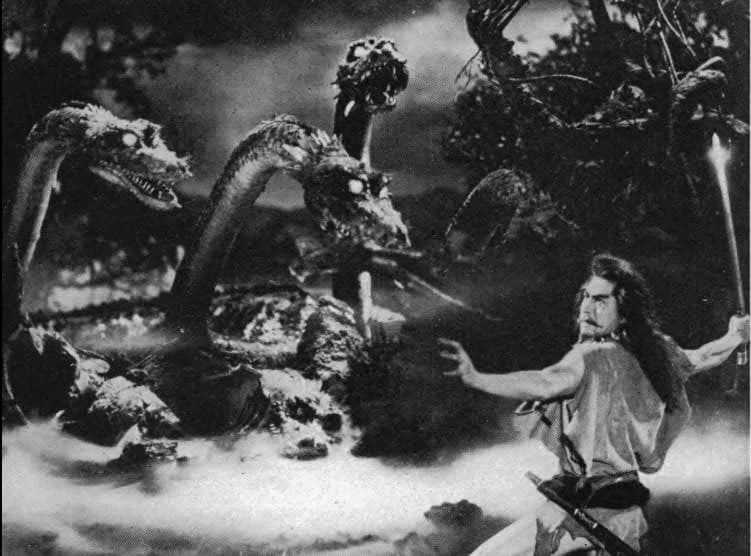
In The Three Treasures, Tsuburaya’s shots of the sea serpent were combined with scenes of the star, Mifune, to show him battling the monster. Here careful planning of angles and relative image sizes was most important so that both film segments would match when put through the optical printer.
Tsuburaya is successful because he is an inveterate experimenter. From his experience he might have a good idea at what speed a camera should turn to show a miniature storm realistically on the screen, but if he is not sure, he will try the effect in front of a camera.
The storm in The Three Treasures offers some excellent examples of his work with miniatures. The ship models were made with such infinite detail that he was able to move his cameras in for screen-filling closeups of the tiny oarsmen models who propelled the ancient ships. The speed of the action corresponds well with the shots which include live actors and gives a strong illusion of reality.
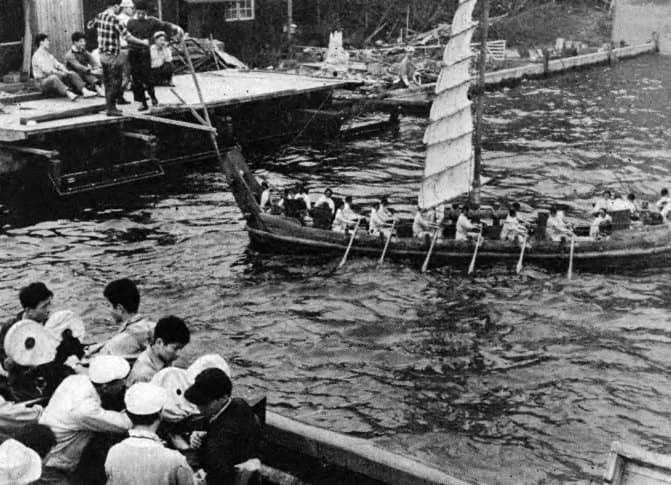
Tsuburaya also has a penchant for working out simple methods for filming visual tricks. The star of the movie The H-Man was a glob of pulsating jelly, which was required to seep under doors and climb walls, as if it were alive. Tsuburaya and his assistants compounded a special chemical preparation for this. In front of the camera they forced it under pressure through the cracks in the various sets.
The wall-climbing bit was about as simple. Tsuburaya just had the workmen construct the sets upside down and with the camera grinding in the normal upright position he filmed the jelly running downhill. In the finished sequence the goo appears to crawl in defiance of gravity.
Later he and his men were faced with the problem of showing the persons contaminated by the jelly, shriveling and wasting away. Tsuburaya’s craftsmen fashioned dummies from air-tight, rubber bags and substituted them for the live actors. As the cameras rolled in slow motion, the air was allowed to escape. On the screen the dummies collapse and shrivel in size realistically.
Recently we went behind closed doors to watch Tsuburaya at work on a new science-fiction picture entitled World Of Space, the story of earth men fighting a war with celestial invaders.
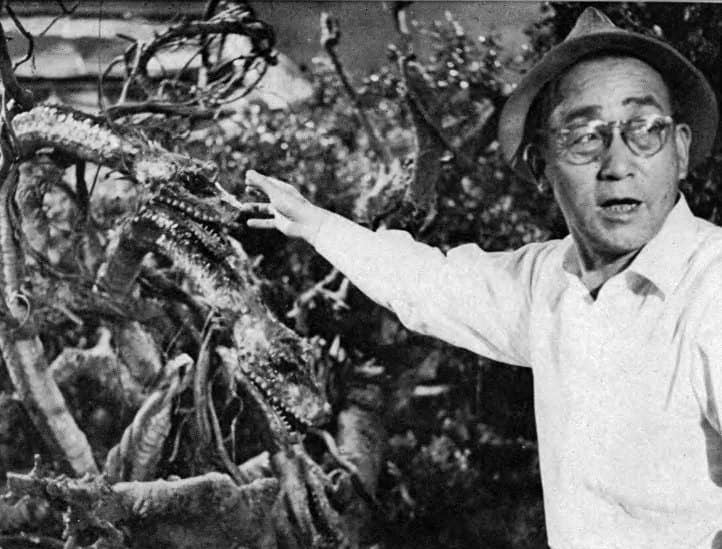
Tsuburaya was dividing his attention between his cameramen who were placing a Mitchell at one end of the stage and his technicians who were connecting wires to a space missile at the other. He and his key assistants were gathered around a charcoal burner to warm their hands and plan the next shot.
When the men had completed their preparations, Tsuburaya arose and supervised several trial runs. When he was satisfied with the results, the camera was turned on and the plastic missile with colored lights blinking hurtled through space. After two takes the shot was “in the can.”
While his men were setting up for the next shot, we were invited to join the circle around the charcoal burner and Tsuburaya related some of the details of his work for The Three Treasures. One of the major jobs, he indicated, was filming the eruption of Mt. Fuji. This sequence provides the forceful climax for the picture.
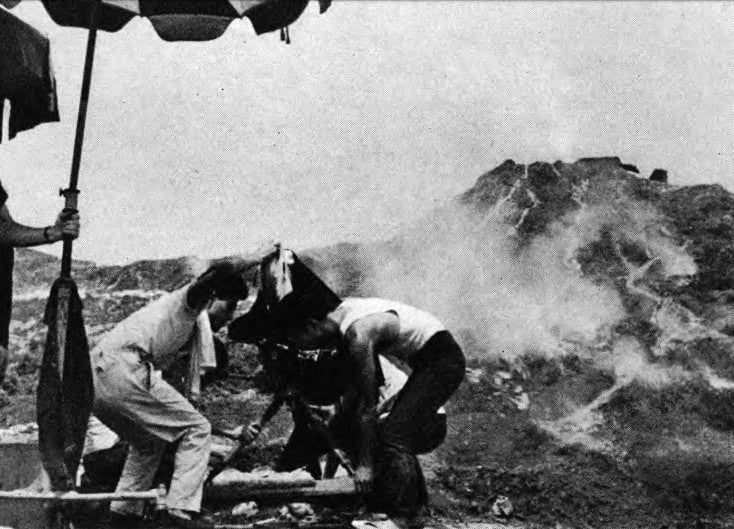
A 15-foot replica of the mountain was built in the studio pool, the only area large enough for it in the cramped back lot. After the top was blown off with gunpowder, vats of molten lead were poured over the crater to simulate lava. The eruption and subsequent lava flow were picked up in slow motion with several cameras to obtain a variety of angles at one shooting.
“In such work as this, which calls for extreme slow motion, I often use a Debrie camera turning at 240 frames per second,” he said.
The mythical reptile for the picture was made in miniature, but for several closeups with the star, a section was built “life size.” Both models were moved by a complex system of overhead wires. On the screen the action is strikingly lifelike.
Tsuburaya brings to his present job years of experience in numerous fields of movie work. He began his career as a scenario writer and later was employed in the studio laboratory. Using the latter job as a stepping stone, he graduated to the camera where he worked for fifteen years.
“Several years before World War II, I was called upon to create and photograph a monkey-like monster which was supposed to fly through the air,” he said. “I managed the job with some success and this assignment set the pattern for my future work.”
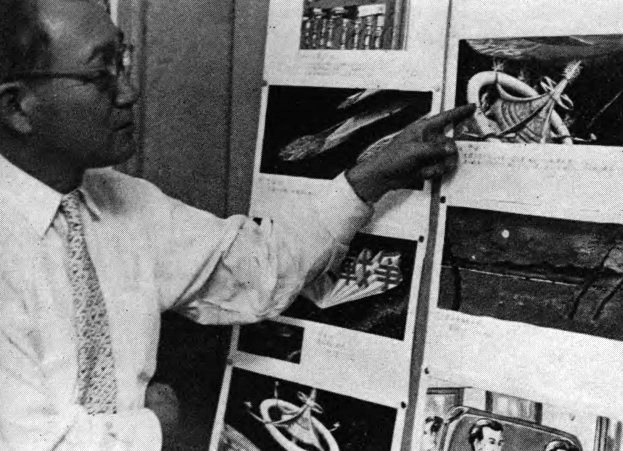
After the war, he continued working on science-fiction films, each with a new monster and new photographic problems. As he moved up the ladder of responsibility he took on more duties until today he is master of his own crew. Basically, however, he still is a director of photography.
Tsuburaya’s years behind the camera and in the laboratory have given him an expert’s knowledge of what effects can be achieved with camera speeds, lenses and the machines available in the printing room. His study of chemicals, plastics, woods, metals and fabrics, the raw materials of his miniatures, provides him with an indication of what can be created from them and how they will appear on the screen.
“Because I am especially interested in the visual results,” Tsuburaya said, “our pictures are plotted on a story board much in the same manner that cartoons are diagrammed in Hollywood. Here production kinks are worked out in advance.”
We asked Tsuburaya where he gets the ideas for some of his weird creations. Usually they come from his own imagination, he reported. Even a dream or two has provided the basis for a picture.
What hideous monster is he planning for the cameras next?
“Perhaps my next nightmare will give me the answer,” he said.
